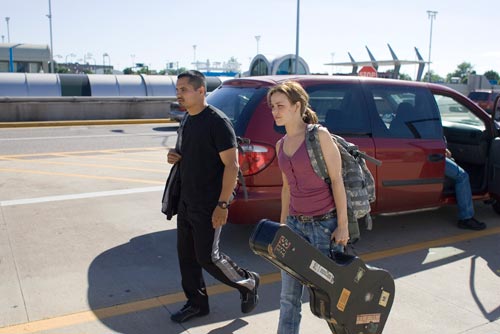
Let's suppose for a minute that it's OK for a movie to be completely, flat-out, sponge-brained preposterous.
A woman rings up Shia LaBeouf, tells him the FBI will be at his door in 3, 2, 1 -- boom -- enter the FBI. This woman continues to be prescient, wait, not just prescient but able to control every object in Chicago that runs on 'lectricity. She can dial any phone, swing any crane, and reverse any El. She can put messages on the screens at McDonald's, flip the traffic lights to Mr. LaBeouf's favor, and dispense orders from the FBI's fax machine. I bet she could even update your Facebook status without your knowledge. She's just that connected.
Fine. Let's accept that. She rings up Mr. LaBeouf -- Jerry, a regular guy who works at Copy Central -- to tell him that he's "been activated," which is a euphemism for being framed by a disembodied, preternaturally connected female voice. Jerry is to meet up with Rachel (Michelle Monaghan) who's been comparably activated. The voice tells them to drive to such and such and do something, and since they're running from the FBI, having been framed, this trip involves not a leisurely drive but a massive car chase, shown with such fast cutting that I began to feel somewhat activated myself by the end of the first big crash-up.
Here's my problem. In real life, a menace that's everywhere and unescapable would be terrifying. But in movies, it's the locatable killer who generates more suspense. A man with an axe is bound by the laws of physics, so our minds calculate where he might be. Behind the door? In the basement? Out back? The killer who's everywhere -- in your dreams, your brain, your walls and drains and household appliances -- has it too easy.
Eagle Eye isn't a horror film, but the same principle applies. I don't mind that it makes no sense. I mind that it makes no suspense. (Har har.)
Thanks to her impressive reach, the voice is able to coerce Jerry and Rachel into a mission against their will and, I must say, one that could have been accomplished by simpler means. Billy Bob Thornton and Rosario Dawson -- two cogs in this Rube Goldberg machine -- are the straight-talking authorities pursuing our coerced pair of everypeople. As they were in The Fugitive, the cats and mice are likable in this film. For his previous movie, Disturbia, director D.J. Caruso borrowed heavily from Hitchcock's Rear Window, and this time he's consciously mining North by Northwest (a man is roped into a scheme he cares nothing about) and The Man Who Knew Too Much (a set piece is built around a musical crescendo). And by the end he even folds Stanley Kubrick's 2001: A Space Odyssey into the mix.
Say, where is the menace in 2001? He's everywhere, it seems. The HAL-9000 computer has a red glowing eye in every part of the ship. But the points of tension in Kubrick's film, the iconic conflicts between man and machine, generate suspense by constraining HAL's location: the astronauts step into a docked pod so HAL won't hear them, negotiate with HAL to get back into the ship, and dismantle HAL by entering his physical memory.
Eagle Eye isn't so carefully considered, of course, and it has only one layer of metaphor to 2001's two thousand and one. It's built around a single, reasonably clever analogy that says we're all slaves to something that I shall not reveal in this review. You'll have to see the film. But if answering that question sustains your interest, you're a more activated person than I.








